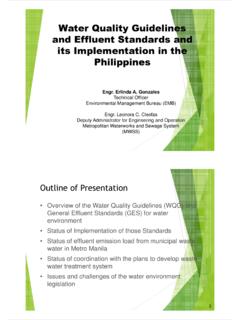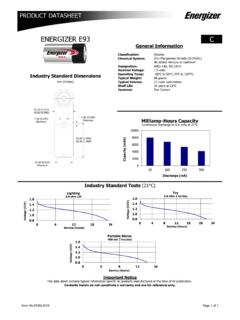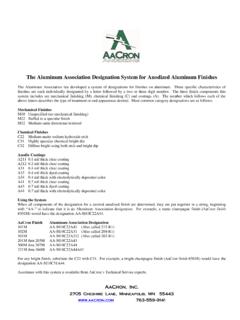Transcription of APPENDIX C Biological Criteria: National Program …
1 APPENDIX C Biological criteria : National Program Guidance for Surface Waters WATER quality standards HANDBOOK SECOND EDITION United States Office of Water EPA-440/5-90-004 Environmental Protection Agency Regulations and standards (WH-585) Agency Washington, DC 20460 EPA Biological criteria National Program Guidance For Surface Waters Biological criteria National Program Guidance for Surface Waters criteria and standards Division Office of Water Regulations and standards U. S. Environmental Protection Agency 401 M Street Washington 20460 Contents Acknowledgments .. Dedication .. Definitions .. Executive Summary . Part I: Program Elements .. iv .. iv .. v .. vii 1. Introduction .. Value of Biological criteria .. Process for Implementation .. Independent Application of Biological criteria .
2 How to Use This Document .. 2. Legal Authority .. Section 303 .. Section 304 .. Potential Applications Under the Act .. Potential Applications Under Other Legislation .. 3. The Conceptual Framework .. Premise for Biological criteria .. Biological Integrity .. Biological criteria .. Narrative criteria .. Numeric criteria .. Refining Aquatic Life Use Classifications .. Developing and Implementing Biological criteria .. 3 4 6 7 7 9 9 10 10 10 13 13 14 14 15 16 17 18 ii 4. Integrating Biological criteria in Surface Water Management .. 21 Implementing Biological criteria .. 21 Biological criteria in State programs .. 22 Future Directions .. 24 Part II: The Implementation Process 5. The Reference Condition .. 27 Site-specific Reference Condition .. 28 The Upstream-Downstream Reference Condition.
3 28 The Near Field-Far Field Reference Condition .. 28 The Regional Reference Condition .. 29 Paired Watershed Reference Condition .. 29 Ecoregional Reference Condition .. 29 6. The Biological Survey .. 33 Selecting Aquatic Community Components .. 34 Biological Survey Design .. 35 Selecting the Metric .. 35 Sampling Design .. 36 7. Hypothesis Testing: Biological criteria and the Scientific Method .. 37 Hypothesis Testing .. 37 Diagnosis .. 38 References .. 43 APPENDIX A: Common Questions and Their Answers .. 45 APPENDIX B: Table of Contents; Biological criteria -Technical Reference Guide .. 49 APPENDIX C: Table of Contents; Biological criteria -Development By States .. 51 APPENDIX D: Contributors and Reviewers .. 53 iii Acknowledgments Development of this document required the combined effort of ecologists, biologists, and policy makers from States, EPA Regions, and EPA Headquarters.
4 Initial efforts relied on the 1988 document Report of the National Workshop on Instream Biological Monitoring and criteria that summarizes a 1987 workshop sponsored by the EPA Office of Water Regulations and standards , EPA Region V, and EPA Environmental Research Laboratory-Corvallis. In December 1988, contributing and reviewing committees were established (see APPENDIX D). Members provided reference materials and commented on drafts. Their assistance was most valuable. Special recognition goes to the Steering Committee who helped develop document goals and made a significant contribu- tion toward final guidance. Members of the Steering Committee include: Robert Hughes, Chris Yoder Susan Davies Wayne Davis John Maxted Jimmie Overton James Plafkin, Dave Courtemanch Phil Larsen, Finally, our thanks go to States that recognized the importance of a Biological approach in standards and pushed forward independently to incorporate Biological criteria into their programs .
5 Their guidance made this effort possible. Development of the Program guidance document was sponsored by the EPA Office of Water Regulations and standards and developed, in part, through EPA Contract No. 68-03-3533 to Dynamac Corporation. Thanks to Dr. Mark Southerland for his technical assistance. Suzanne K. Macy Marcy, Editor In Memory of James L. Plafkin, iv Definitions T o effectively use Biological criteria , a clear understanding of how these criteria are developed and ap- plied in a water quality standards framework is necessary. This requires, in part, that users of Biological criteria start from the same frame of reference. To help form this frame of reference, the following defini- tions are provided. Please consider them carefully to ensure a consistent interpretation of this document.
6 Definitions q An AQUATIC COMMUNITY is an association of in- teracting populations of aquatic organisms in a given waterbody or habitat q A Biological ASSESSMENT is an evaluation of the Biological condition of a waterbody using biologi- cal surveys and other direct measurements of resi- dent biota in surface waters. q Biological criteria , or biocriteria, are numeri- cal values or narrative expressions that describe the reference Biological integrity of aquatic communities inhabiting waters of a given designated aquatic life use. q Biological INTEGRITY is functionally defined as the condition of the aquatic community inhabiting unimpaired waterbodies of a specified habitat as measured by community structure and function. q Biological MONITORING is the use of a biologi- cal entity as a detector and its response as a measure to determine environmental conditions.
7 Toxicity tests and Biological surveys are common biomonitoring methods. q A Biological SURVEY, or biosurvey, consists of collecting, processing and analyzing representative portions of a resident aquatic community to deter- mine the community structure and function. q A COMMUNITY COMPONENT is any portion of a Biological community. The community component may pertain to the taxomonic group (fish, inver- tebrates, algae), the taxonomic category (phylum, order, family, genus, species), the feeding strategy (herbivore, omnivore, carnivore) or organizational level (individual, population, community association] of a Biological entity within the aquatic community. q REGIONS OF ECOLOGICAL SIMILARITY describe a relatively homogeneous area defined by similarity of climate, landform, soil, potential natural vegeta- tion, hydrology, or other ecologically relevant vari- able.)
8 Regions of ecological similarity help define the potential for designated use classifications of specific waterbodies. q DESIGNATED USES are those uses specified in water quality standards for each waterbody or seg- ment whether or not they are being attained. q An IMPACT is a change in the chemical, physical or Biological quality or condition of a waterbody caused by external sources. q An IMPAIRMENT is a detrimental effect on the Biological integrity of a waterbody caused by an im- pact that prevents attainment of the designated use. q A POPULATION is an aggregate of interbreeding in- dividuals of a Biological species within a specified location. q A WATER quality ASSESSMENT is an evaluation of the condition of a waterbody using Biological sur- veys, chemical-specific analysis of pollutants in waterbodies, and toxicity tests.
9 Q An ECOLOGICAL ASSESSMENT is an evaluation of the condition of a waterbody using water quality and physical habitat assessment methods. v Executive Summary T he Clean Water Act (Act) directs the Environmental Protection Agency (EPA) to develop programs that will evaluate, restore and maintain the chemical, physical, and Biological in- tegrity of the Nation s waters. In response to this directive, States and EPA implemented chemically based water quality programs that successfully addressed significant water pollution problems. However, these programs alone cannot identify or address all surface water pollution problems. To create a more comprehensive Program , EPA is setting a new priority for the develop- ment of Biological water quality criteria . The initial phase of this Program directs State adoption of narrative Biological criteria as part of State water quality standards .
10 This effort will help States and EPA achieve the objectives of the Clean Water Act set forth in Section 101 and comply with statutory requirements under Sections 303 and 304. The Water quality standards Regulation provides additional authority for Biological criteria development. In accordance with priorities established in the FY 1991 Agency Operating Guidance, States are to adopt narrative Biological criteria into State water quality standards during the FY 1991-1993 trien- nium. To support this priority, EPA is developing a Policy on the Use of Biological Assessments and criteria in the Water quality Program and is providing this Program guidance document on Biological criteria . This document provides guidance for development and implementation of narrative Biological criteria .



















